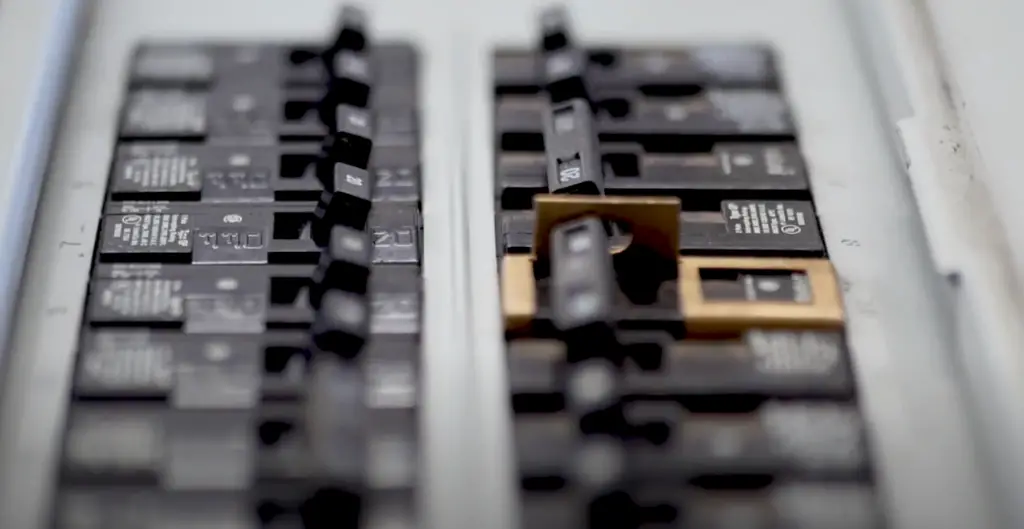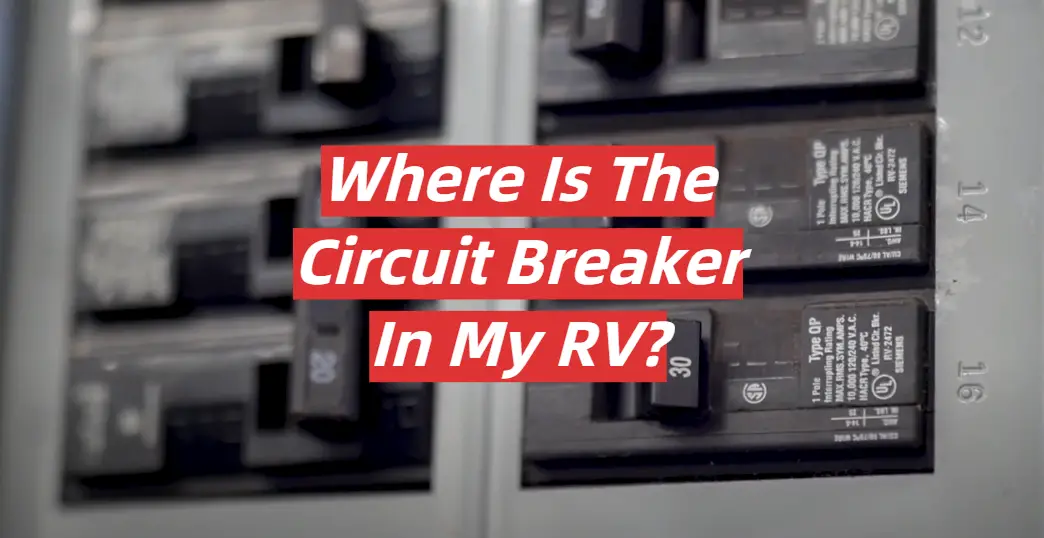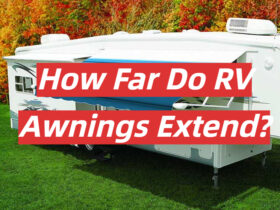It is wonderful to have an RV. You can travel anywhere without leaving your home. However, sometimes you will have to make small repairs. Thus, it is important to know about all the important parts of your RV. One of them is the circuit breaker. It plays a very important role in the whole electrical system of your vehicle.
If you have just bought an RV, you should not worry about finding the circuit breaker. Quite often, it looks like a panel, installed in a box. It can be covered with a plastic or metal door. Most of them are located near the floor or wall. They also can be under the bed or other furniture. Sometimes you can find it inside of exterior storage bays. Certain RVs have circuit breakers installed outside.
Table of Contents
What is a Circuit Breaker?
A circuit breaker is an automatic switch that cuts off the passage of electrical current if certain conditions are met, such as voltage fluctuations. Unlike fuses, which are for single-use, an electrical circuit breaker or breaker can be reconnected as long as the causes that activated it has been resolved. When purchasing these components you have to take into account certain characteristics, such as:
- work voltage
- nominal current
- breaking capacity
- closing power
- the number of poles.
The most used in domestic installations are generally thermomagnetic and differential.
Thermomagnetic Circuit Breakers
This device is in charge of cutting off the passage of current when it exceeds a certain threshold. Thermomagnetic (thermal) switches are used primarily to protect electrical cables and conductors against overloads and short circuits. In this way, they assume the protection of electrical means against excessive heating. Each of the circuits that are installed has its own thermomagnetic circuit breaker.

They are designed to withstand the current peaks that are generated during the ignition of electric motors. Thermomagnetic (thermal) switches are used primarily to protect electrical cables and conductors against overloads and short circuits. In this way, they assume the protection of electrical means against excessive heating.
They are composed of two fundamental parts, as the word indicates: a magnetic part and a thermal part. The magnetic relay is the part in charge of short circuit protection and the thermal relay is the part of the circuit breaker in charge of overload protection. The Thermals open and cut the circuit when an intensity greater than the nominal one passes through them.
Differential Circuit Breakers
This device is responsible for protecting people from electric shocks. It works in conjunction with the earth connections of all installation elements. Compare the intensity that enters the circuits, with the one that leaves. If everything is correct, they should be the same and the switch remains closed, allowing electricity to pass through. If, for example, you came into contact with some part of the installation and suffered a shock, the output intensity would be lower, activating the switch that would cut the current.
This device protects us from the consequences that may arise from a current leak in our installation. It is called differential because it is capable of measuring the possible difference between the input current and the return current in an electrical system.
Although there are switches for different actuation intensities, high sensitivity differential switches are installed in domestic installations, which guarantees adequate protection for people. A wide range of automatic switches, with various control units and the possibility of communicating with programmable controllers.
Circuit Breaker Functions
In addition to reducing the space required for protection circuits, making the process of driving motors cheaper and more efficient, the component has several functions. Therefore, the device is able to provide more stable, safe, and reliable circuits.
Overload Protection
The component can interrupt the flow of current in case of overload, by means of a thermal trigger in its contact blades. This thermal protection works from two metal sheets, with different coefficients of expansion. When an overload occurs, the temperature rises causing these blades to deform, closing the circuit.
Short Circuit Protection
It works from a coil, which when energized with a current much higher than the rated current of the equipment creates a magnetic field that activates the switch and turns off the circuit.
Switching
It keeps the motor voltage separate and at the same time turns the equipment itself on and off, replacing a switch for connection and even a contactor.
Advantages of The Circuit Breaker
Some of the advantages are that the circuit breakers are reconnectable and do not require replacement items, such as fuses. They have a high breaking capacity, which means that they can be used even in places with a high level of short-circuit current. In some cases, the component does not require other protection circuits.
The circuit breaker guarantees total protection for the motor and the electrical circuit with its thermal and magnetic triggers. Auxiliary contacts can be connected to some models, if necessary.
Therefore, the circuit breaker is still capable of withstanding starting currents, that is, currents up to ten times the rated current without affecting its protection against adversity. The most important thing is to regulate the component according to the circuit in which it will be used.
Therefore, when installing a circuit breaker, you must adjust it to the motor rating. The circuit breaker allows the current to flow without interruption during the motor starting period, where higher currents are required.
Electricity in the RV: The On-Board Battery
In the mobile home, there are two separate batteries in general, unless you have an additional body battery for increased self-sufficiency on board. One battery for the chassis and a second for the living area. This means that if the (on-board) battery in the living area should be empty, the engine will still start thanks to the other battery.
What Works In The Motorhome Only With The On-Board Battery?
- Light: The on-board battery is used here if there is no shore power available. You almost exclusively use LEDs in vehicles, so the light uses very little of the battery.
- Toilet flush: This is also operated by the on-board battery. So there is no mishap.
- Herd: It runs on gas, so it doesn’t need any electricity.
- Heating: As long as you have gas onboard and your on-board battery is not empty, the heating in the motorhome works – even without shore power. Because the 12 V supply from the living area battery is enough to operate the gas heating.
- Fridge: In most motorhomes, the refrigerator runs on gas and is switched to electricity as soon as the vehicle is connected to an external power source. However, modern refrigerators always need electricity, even if they run on gas. However, this current can also be taken from the on-board battery.
Small automatic switches (PIA)
The circuit breakers serve to protect installation (the cables) from an overcurrent (overload) or short circuit. There will be as many PIAs as there are different circuits inside the vehicle.
Normally for RV, the cable should have a section of 2.5 mm and therefore it should have the protection of 16 Amps, which depending on the caliber of these, will fire sooner or later. The circuit breakers are available in different nominal currents (10, 16, 20, 25, 40, and 63 A).
Depending on the caliber of the circuit breakers, the trip at a different intensity, so the cable to be installed must be:
- 10 Amps: Protects cable with a section of 1.5 mm² (Lighting)
- 16 Amps: Protects cable with 2.5 mm² section (Power outlets)
- 20 Amps: Protects cable with a section of 4 mm² (Kitchen appliances)
- 25 Amps: Protects cable with 6 mm² sections (Oven and glass-ceramic)
FAQs
What to Do In Case the Circuit Breaker Tripped?
Sometimes you may find yourself in the RV doing daily tasks and suddenly the power goes out. You simply go to check the mainboard, where you find that the circuit is down. After uploading it, you wait only seconds and the same thing is repeated, again the circuit breaker trips and the light goes out.
This happens because circuit breakers are designed to “jump” and cut off the power supply when some kind of fault or malfunction occurs in the electrical circuit. To solve the issue it is always better to call the specialist. Nevertheless, there are alternative solutions.
Alternative solutions
As another alternative, if you do not contact a professional electrician, what you can do is go to the mainboard to disable the thermals and differentials corresponding to the circuit. Then disconnect all the electrical appliances and enable the thermals and differentials again. Reconnect the electrical appliances one by one, verifying which appliances would be conducting a ground leakage.
In the event of detecting that an appliance has a ground leakage, do not reconnect it and take it to the corresponding technician so that they can check it and leave it in optimal condition.
Other Causes of Tripping Circuit Breakers
Short Circuit: Some indicators that this fault may be happening are:
- Cables are damaged or melted.
- Outlets and plugs have a burning smell or have dark stains.
- Cracked wire insulation.
In this case, if you are going to check the aforementioned on your own, first confirm that the power is turned off in the socket where the device is connected. If you detect any of these situations then contact an electrician, as a power failure of this type is not something that should be left unresolved.
A ground fault is a type of short circuit. A quick way to detect it is by using a device called a Grounding Tester. This device is plugged into the outlet, and once connected the button is pressed. If the circuit breaker trips when pressed, then it means that the electrical circuit is working well.
If nothing happens when pressing the button then it means that there is a ground fault in the circuit. In this case, you again should contact an electrician to solve it. The good thing about a grounding tester is that it is not an expensive device, it is simple to use and it can prevent future electrical accidents.
How To Connect RV To The External Power Source?
If you want to connect your RV at parking spaces and camping areas you will need cables. It is one power cable that is long enough or you can have a cable drum. Most of these wires are adaptable to match various charging situations. Thus, they have CEE adapters. You simply use them into the outside socket of the RV.
Most models of RV and trailers have power sockets outside of the vehicle. You may have difficulties to find it in the beginning as it can be hidden under a cover at the sidewall, bottom of the floor, and the rear. They can be already connected via CEE connection sockets through 230V power supply cables.
It may happen that your default cable is rather short. You should check it before going on a long trip. Thus, you will be able to prepare by getting an additional cable drum to serve as an extension cable. It greatly solves the time when you park near power sources.
How to Install the Ground Connection in a Camper Van?
The way to install the ground connection in a home vehicle is as follows:
- From the external charging socket, take a cable to the general protection panel.
- From the general protection panel, start with another cable to each plug, inverter, battery charger, boiler, or any electrical element installed in the vehicle that has a terminal for grounding. Also, connect another wire to any screw on the vehicle’s chassis.
- Join all the cables in a junction strip in the general protection panel.
- The color of the ground wire has to be yellow/green, and the cross-section has to be equal to or greater than the current wires.
How do I know when the circuit breaker has tripped?
If the circuit breaker in an RV has tripped, you will typically notice a loss of power on that particular circuit. Usually, this can be checked by resetting the switch and seeing whether or not power is restored to your device. If so, then it was likely a false alarm and no further action is required. However, if you find that the power still doesn’t return after resetting the breaker, then it’s likely that an overload has occurred which needs to be addressed. In this case, you may need to check for faulty wiring or any other potential electrical issues before proceeding with resetting the breaker again.
What should I do if the circuit breaker trips while I’m driving?
If the circuit breaker trips while you are driving, it is important to stop as soon as possible and address the issue. You should first try resetting the circuit breaker by flipping the switch located near your RV’s power panel. If this does not work, you may need to check the wiring and electrical connections for any loose or damaged parts. Additionally, be sure to check if there is a blown fuse that needs replacement. It is essential to take all necessary safety precautions when dealing with electricity in your RV. Make sure to have proper gloves and protective eyewear on hand whenever working on your RV’s electrical systems. If problems persist, contact an electrician or technician who can help ensure everything is operating safely and properly.
How do you reset a circuit breaker in an RV?
Resetting a circuit breaker in an RV is similar to resetting one in any other type of building. First, locate your RV’s main electrical panel. If the panel has a door, it will usually be labeled with something like “Main Electrical Panel” or “Distribution Center”. Once you have located the panel, open it and look for the circuit breakers inside. Most are labeled with their intended purpose (e.g., water heater, air conditioner). If your circuit breaker looks tripped (there should be a switch that flips up/down), all you need to do is switch it back down into its normal position.
Are there any steps that should not be taken when resetting a circuit breaker in an RV?
Yes, there are certain precautions to take when resetting a circuit breaker in an RV. Electricians and other qualified professionals should always be consulted before attempting any repairs or maintenance on the electrical system of an RV. Additionally, while resetting the circuit breakers, it is important to keep your hands away from live wires and circuits as they may still have current running through them. Make sure to unplug all appliances and turn off any lights that are connected to the circuit you’re working on before resetting the breaker. It is also important not to reuse a circuit breaker if it has been tripped more than once- replace with a new one if necessary.
Are there any warning signs that indicate that the circuit breaker has been tripped?
Yes, there are some warning signs that indicate when your circuit breaker has been tripped. These can include a lack of power to an appliance or device in the RV, flickering lights, and buzzing or humming noises coming from the electrical panel. If any of these symptoms appear, it could mean that the circuit breaker has been tripped and needs to be reset. To do this, simply locate the circuit breaker in your RV and flip the switch back to its original position. You may also need to check for any loose or frayed wiring as this is common cause of circuit breakers being tripped.
Is it possible to overload the circuit breaker in an RV?
Yes, it is possible to overload the circuit breaker in an RV. When too much electricity is drawn from the electrical system at once, the circuit breaker can trip and shut off power to prevent damage or fire. To avoid tripping your RV’s circuit breaker, be sure not to connect more appliances than your onboard electrical system can handle. Also make sure you are using the correct wiring and outlets for each appliance. Monitor the voltage of your RV’s battery regularly and never go over 13 volts while driving. If you suspect that your circuit breaker has been overloaded, contact a qualified technician right away.
Where is the reset button on a camper?
The reset button, or circuit breaker, on a camper is typically located next to the power cord. It’s usually housed in a box or enclosure and can be identified by its red reset button. If your RV is equipped with an AC/DC converter, the circuit breaker may also be located there. In some cases, it may also be under the hood of the RV near the battery bank.
Why are my RV outlets not working?
If you’ve noticed that your RV’s outlets are not working, it can be frustrating and disorienting. The first thing you should do is to check the circuit breaker panel. In most cases, the circuit breaker in an RV will be located near the entrance door or inside a storage area close to the electrical system. It should have visible markings with individual switches for each outlet or appliance so that you can easily determine which one is responsible for a particular power source. By resetting the switch associated with an outlet or appliance that isn’t working, you may find that it begins to function normally again.
How do I fix my RV outlet not working?
If your RV outlet isn’t working, the issue is likely due to a tripped circuit breaker in the electrical panel. To fix this issue, locate and reset the correct circuit breaker for that outlet.
Before attempting to fix or reset any circuit breakers in your RV, make sure to turn off the main power switch on the RV. Then, you’ll need to find the electrical panel inside your vehicle. This will usually be located near either side of a wall or cabinet. Open up the cover on the panel and locate the specific circuit breaker related to your non-working outlet. If it has been tripped, simply flip it back up until it clicks into place and all lights should come back on.
How do you find an electrical short in an RV?
If you suspect that an electrical short is causing an issue in your RV, the first step is to find and reset the circuit breaker. Depending on the RV model, the circuit breakers can be located in different areas. If your RV has a separate electrical system for the chassis and coach, there may be more than one location.
In some RVs, all of the breakers are combined into one main panel. This panel will typically be near where all of your RV’s electrical cords connect or near your onboard battery. It’s also possible that this panel could be found inside a storage compartment or up high near the roofline; it could even be under a bench seat or inside a cabinet.
Do my RV outlets work on battery?
Yes, most RV outlets are wired to work on battery power. If you’re having trouble getting your outlets to work, it may be because the circuit breaker is tripped. The circuit breaker in an RV is usually located in a box near the back of the unit. You can also find it next to the converter/charger or fuse panel. To reset the circuit breaker, simply turn it off and then back on again. Make sure that all of your appliances are turned off before you do this so that no damage occurs when you reset it. Your outlets should now be working once again! If not, try checking for any loose wiring connections or other issues with your electrical system before calling a professional for help.
Related Video: Breakers and Fuse Panel Explained for RVs
Final Words
Knowing where the circuit breaker is in your RV can help you avoid damage to your vehicle, as well as ensure the safety of yourself and others. In most cases, you can locate the box in the same area near the entrance door of an RV. If you are having trouble, consider reaching out to a technician for help with locating and resetting the breaker.






Leave a Reply